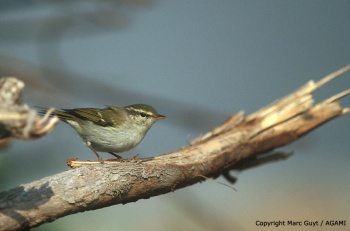Alternative name: Two-barred Greenish Warbler
- Phylloscopus plumbeitarsus
Identification
11·5–12 cm (4½-4¾ in). A medium-sized leaf warbler:
- Yellowish-white supercilium
- Two prominent white wingbars on median and greater upperwing-coverts (median-covert bar can be absent in worn plumage)
- Dark olive-green crown and upperparts
- Dark brown flight-feathers, finely edged bright green
- Primaries with narrow whitish tips
- Brown tail with olive-green edges
- Whitish underparts
- Washed with grey on throat, breast and flanks
- Dark brown eye
- Bill with brown upper mandible, yellow to pinkish under mandible
Sexes similar. Juveniles is slightly browner on upperparts, has a yellowish-buff supercilium and yellowish wingbars.
Similar species
Differs from Greenish Warbler by slightly darker green upperparts, very little or no yellow on underparts, longer and broader bar on greater coverts, more prominent bar on median coverts. Perhaps not safely separated in worn plumage.
Larger than Yellow-browed Warbler, has a longer tail, a pale lower mandible and no pale tips on tertials.
Distribution
Breeds from southern Siberia to Mongolia and east to Manchuria, winters in southeast Asia.
Has been recorded as vagrant in Europe.
Taxonomy
This is a monotypic species.
Often included as subspecies in Greenish Warbler.
Habitat
Found in mixed deciduous and conifer forest of the Taiga and birches along river valleys. Occurs up to 4000m.
In winter in deciduous and secondary forest, scrub and bamboo up to 1300m.
Behaviour
Diet
Very little information about diet, small insects recorded.
Forages singly, in pairs or in winter in mixed-species flocks.
Breeding
Little information about breeding. Breeding season from May to early August. The nest is ball-shaped and made of moss, grass stems, leaves and hair. It's placed on the ground. Lays 5 to 6 eggs.
Movements
A migratory species.
References
- Clements, J. F., T. S. Schulenberg, M. J. Iliff, D. Roberson, T. A. Fredericks, B. L. Sullivan, and C. L. Wood. 2018. The eBird/Clements checklist of birds of the world: v2018. Downloaded from http://www.birds.cornell.edu/clementschecklist/download/
- Del Hoyo, J, A Elliot, and D Christie, eds. 2006. Handbook of the Birds of the World. Volume 11: Old World Flycatchers to Old World Warblers. Barcelona: Lynx Edicions. ISBN 978-8496553064
- Gill, F and D Donsker (Eds). 2010. IOC World Bird Names (version 2.7). Available at http://www.worldbirdnames.org/.
Recommended Citation
- BirdForum Opus contributors. (2025) Two-barred Warbler. In: BirdForum, the forum for wild birds and birding. Retrieved 2 January 2025 from https://www.birdforum.net/opus/Two-barred_Warbler
External Links
GSearch checked for 2020 platform.





